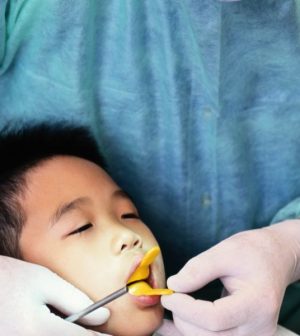- Navigating Your Midlife Crisis: Embracing New Possibilities
- City Raccoons Showing Signs of Domestication
- Mapping the Exposome: Science Broadens Focus to Environmental Disease Triggers
- One Week Less on Social Media Linked to Better Mental Health
- Your Brain Changes in Stages as You Age, Study Finds
- Some Suicide Victims Show No Typical Warning Signs, Study Finds
- ByHeart Formula Faces Lawsuits After Babies Sickened With Botulism
- Switch to Vegan Diet Could Cut Your Greenhouse Gas Emissions in Half
- Regular Bedtime Does Wonders for Blood Pressure
- Dining Alone Could Mean Worse Nutrition for Seniors
School Dental Care Program Could Cut Cavities in Half: Study

School-based dental care cut cavities in half among thousands of elementary students, a new study says.
“The widespread implementation of oral health programs in schools could increase the reach of traditional dental practices and improve children’s oral health — all while reducing health disparities and the cost of care,” said senior author Dr. Richard Niederman. He’s chair of the department of epidemiology and health promotion at New York University’s College of Dentistry.
Dental cavities are the most common chronic disease in children. One in five elementary school children has at least one untreated cavity, Niederman and his colleagues noted.
Cavities can be prevented with dental visits and good at-home oral hygiene. But some parents struggle to get their children to a dentist because of the cost and having to take time off of work.
“School-based cavity prevention programs eliminate these barriers by bringing basic dental care to children, rather than bringing children to care,” Niederman said in a university news release.
The trial program involved free, twice-yearly visits by dental hygienists to nearly 7,000 students at 33 public, high-need elementary schools in Massachusetts.
The visits included: dental examinations; cavity prevention and treatment, including fluoride varnish and sealants; and minimally invasive fillings to stabilize cavities without drilling. The students also received oral hygiene instructions, toothbrushes and fluoride toothpaste to take home.
Students who required more complex care were referred to local dentists.
After six visits, there was a more than 50% decline in untreated cavities. In one group of schools, the rate of cavities fell from 39% to 18%, and decreased from 28% to 10% in a second group of schools.
Cavities declined in both baby and permanent teeth, according to the study. The results were published March 1 in the Journal of the American Dental Association.
In 2010, the U.S. government set a target of reducing cavities in children by 10% by 2020.
“Our study shows … that a comprehensive school-based program can reduce cavities by five times their goal,” Niederman said.
If this school-based dental program was implemented nationwide, it could reduce Medicaid spending on children’s dental care by as much as one-half, according to the researchers.
More information
The American Academy of Pediatric Dentistry offers resources for parents.
SOURCE: New York University, news release, March 1, 2021
Source: HealthDay
Copyright © 2025 HealthDay. All rights reserved.










